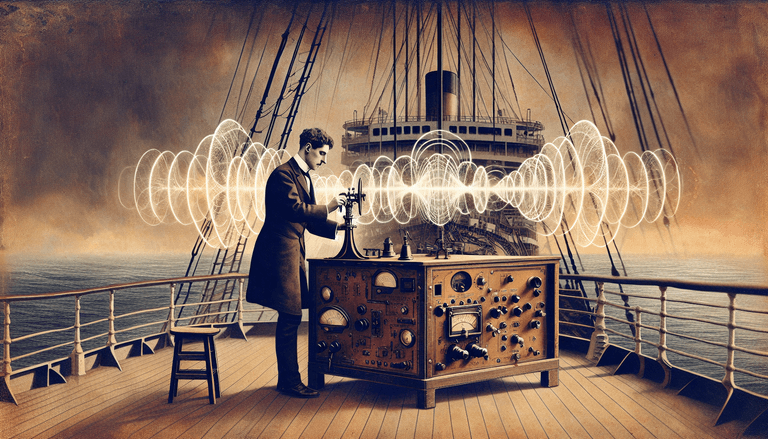Ahoy, dear readers! Imagine if you will, a reality in which Marconi’s ingenious wireless telegraph was given a millennium's worth of upgrades. Imagine the RMS Titanic, that ill-fated leviathan, gracefully gliding through the Atlantic, aided not by the temperamental SOS signals but by the potent all-knowing currents of Wi-Fi. Oh, the tales the iceberg would never tell! But first, let’s embark on a voyage of time-twisting fantasy through fibre-optic waters.
A Sea Change in Communication
In our revised retelling, Marconi, that maestro of morse, finds himself decked out with a gleaming new contraption, a retrofitted wireless internet system. One can only wonder how the events of April 1912 might have unfolded with a seamless 500 Mbps connection and reliable coverage, enough to span both starboard and port.
Picture Captain Edward Smith with not a mere sextant in his hand, but a svelte tablet. Instead of clunky dits and dahs, his fingertips fly over a glowing screen, beaming brisk emails to the iceberg patrol centre. An email subject line screaming "URGENT: Icebergs Ahead, Let’s Zig-Zag!" would have hopefully been enough of a knocker to avert history’s frosty embrace.
Safe Haven in the Cloud
During those unwelcome hours of cold uncertainty, rather than illuminating the skies with flares and firing rocket signals, the radio room might have had rows of blinking routers, emitting the comforting glow of Wi-Fi connectivity. The passengers, huddled with their smart devices, could swipe through weather updates or even get a fresh forecast. What better reassurance for those on the high seas than some notifications amidst a sea of despair?
We’d witness Bartlett, the bespectacled bandleader, sharing his Spotify playlist of soothing “Hold On, Help Is On The Way” tunes while calming fraught guests. Meanwhile, ragtime chatroom threads would flourish as digital chatter filled the night, keeping hopes afloat.
Crowdsourcing a Rescue
The real kicker, the captain, and his crewmates wouldn’t just be broadcasting their plight through whistles but Instagramming it. Perhaps a little live streaming would have sparked a seaborne spam storm, drowning the icy endeavours at the tips of the internet iceberg.
With a bit of networking prowess, the White Star Line’s flagship Twitter account could fire off a frantic SOS thread, inviting charitable ships nearby to slide into their DMs for a collaborative rescue mission. A viral hashtag like #TitanicTrouble could have roared across the social waves, rallying maritime rescuers and an armada of concerned digital citizens.
Predictive Analytics from Poseidon
Even Poseidon himself might have peeked through his virtual telescope, pondering the collective currents. With predictive analytics and IoT-beckoning technology, the Titanic's course could have been charted with the clairvoyance of an oracular octopus.
Thanks to real-time analytics processed in temperature-logged databases, the ship could have navigated around treacherous ice fields. And, if calamity were still fated, the scars of history might have been softened with even more timely lifeboat launches.
Concluding Waves
Of course, in reality, Marconi's wireless telegraph served its day’s purpose as best it could, a heroic and hefty tool that spoke its own primitive language of bleeps and pauses. But in our alternate universe, a Wi-Fi wave swept the Titanic from being the cold catastrophe to the titanic tweet it could have become.
As we cast off from our digital dreamworld, let us give a nod to both past pioneers and their present-day tech counterparts. Here’s to the wink of a “What if?” reminding us that the shoals of innovation remain plentiful in any era, and may we continue navigating such creative waters, Wi-Fi or otherwise.







